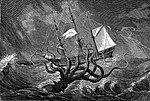All cephalopods possess flexible limbs extending from their heads and surrounding their beaks. These appendages, which function as muscular hydrostats...
15 KB (1,267 words) - 12:28, 5 October 2024
A cephalopod /ˈsɛfələpɒd/ is any member of the molluscan class Cephalopoda /sɛfəˈlɒpədə/ (Greek plural κεφαλόποδες, kephalópodes; "head-feet") such as...
139 KB (15,484 words) - 03:23, 1 November 2024
referring to the corolla of some flowers. Cephalopod limb: The outer shallow cavity of a sucker on a Cephalopod limb is called an infundibulum. Infundibulum...
2 KB (360 words) - 02:12, 21 November 2020
length is generally considered more reliable than total length because cephalopod limbs may easily be stretched beyond their natural length and are often damaged...
359 KB (29,836 words) - 08:45, 1 October 2024
All extant cephalopods have a two-part beak, or rostrum, situated in the buccal mass and surrounded by the muscular head appendages. The dorsal (upper)...
16 KB (1,924 words) - 08:00, 8 October 2024
nautiloids. Like other cephalopods, an octopus is bilaterally symmetric with two eyes and a beaked mouth at the centre point of the eight limbs. The soft body...
116 KB (12,065 words) - 08:58, 3 November 2024
Cephalopod fins, sometimes known as wings, are paired flap-like locomotory appendages. They are found in ten-limbed cephalopods (including squid, bobtail...
7 KB (650 words) - 03:38, 29 December 2023
transportation, and respiration. All cephalopods, a mollusc phylum, have flexible appendages known as cephalopod limbs. They may have further extensions...
7 KB (821 words) - 12:41, 5 October 2024
Cephalopod attacks on humans have been reported since ancient times. A significant portion of these attacks are questionable or unverifiable tabloid stories...
23 KB (2,994 words) - 02:03, 27 June 2024
the presence of eight arms and two tentacles. Tentacles are retractable limbs used to target and latch onto prey, whereas arms are used for handling prey...
10 KB (759 words) - 05:20, 17 July 2024









